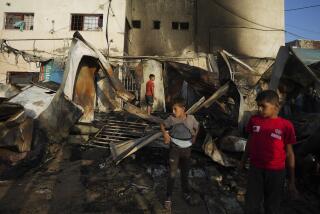A Staggering Request : Be careful not to jeopardize future aid to Moscow
- Share via
A Soviet official, reporting that food production in his country this year will fall 10% to 30% below 1990’s levels, has appealed for $14.7 billion in emergency Western aid to stave off severe shortages or even feared localized famines. The request, vastly larger than what outside experts had expected, has staggered European Community and American officials and been met with a large degree of polite questioning if not outright skepticism.
The doubts go to more than the dollar cost requested, which exceeds the entire amount spent through the Marshall Plan 40 years ago to revive Western Europe’s war-damaged economies.
No less fundamental are uncertainties about the ability of the Soviet distribution system to handle a lot of aid in a short time. Western food that ends up rotting before it reaches consumers--the fate of so much of the Soviet Union’s own output--would be not only unproductive but counterproductive, jeopardizing future humanitarian aid programs.
Western nations, of course, are ready to provide more emergency food shipments and billions in credits and loans for future purchases. But donor countries are still waiting for factual clarification on just how bad the situation is; the Soviet Union’s own notoriously unreliable statistics are not being taken as authoritative.
In the next week or so the European Community will send its own fact-finding mission to seek out answers. Meanwhile, some just completed on-site evaluations by American specialists suggest that the situation, while plainly serious, may not be as critical as some Soviet pronouncements indicate.
The American specialists report that food supplies in the southern republics, in Central Asia and the Caucasus, generally appear to be adequate. Armenia is a critical exception because of disruptions caused by its conflict with neighboring Azerbaijan.
The major problem, say the specialists, is in the urban areas of the huge Russian Federation. But even there the level of shortages may not truly reflect the overall realities of the food supply.
Soviet officials have been warning for months that reduced harvests and a collapsing distribution system presage a hard winter. Western experts think that in response, most households have probably stockpiled as much food as they can manage, providing a cushion to fall back on when officially distributed supplies dry up.
It’s also clear that a lot of food has found its way onto the black market, where--because in one way or another it will be consumed--it also contributes to the total availability.
None of this is meant to minimize the compelling human needs that are at the heart of the matter. A lot of Soviet citizens face shortages and even hunger in the months ahead; they must be helped.
Fortunately, Western Europe, the United States and other countries have stockpiles of surplus commodities that can be drawn on for emergency help. These countries also stand ready to provide credits and loans for later food purchases.
But first they insist on determining the true dimensions of Soviet needs--and Soviet capabilities for managing and fairly distributing the help that is given.
The problem, it’s already clear, is bad enough without it being exaggerated. The donor countries are now, reasonably enough, trying to find out just how bad so they can tailor their responses accordingly.
More to Read
Sign up for Essential California
The most important California stories and recommendations in your inbox every morning.
You may occasionally receive promotional content from the Los Angeles Times.










